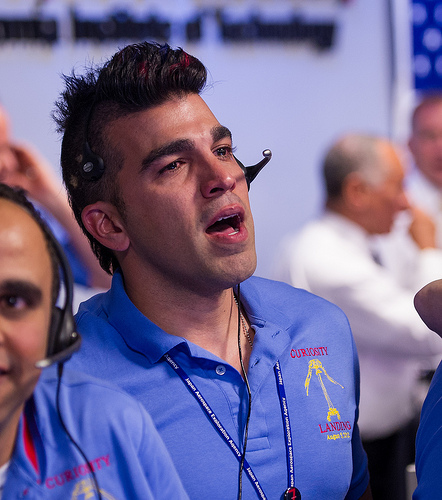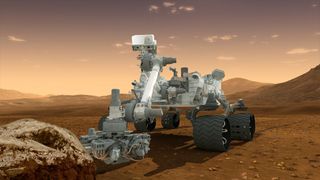
When NASA's Mars rover Curiosity pulled off its daring Red Planet landing on Aug. 5, the 1-ton robot became an international star — and so did Bobak Ferdowsi.
As a flight director for Curiosity's mission, Ferdowsi played a key role in the rover's touchdown success that night. But he got noticed primarily for his American flag-inspired hairstyle, a red- and blue-streaked mohawk set off by white stars on the side of his head.
And so Ferdowsi, who has worked on Curiosity's mission since November 2003, became "Mohawk Guy" to millions of people around the world. He received marriage proposals from strangers, and his Twitter following ballooned, to more than 51,000 as of Friday (Aug. 17).
A music video spoof of Curiosity's Mars landing stars a "Mohawk Guy" lookalike, and President Barack Obama even mentioned Ferdowsi Monday (Aug. 13) in a congratulatory call to Curiosity's handlers at NASA's Jet Propulsion Laboratory in Pasadena, Calif.
"I understand there's a special mohawk guy that's working on the mission," President Obama said. "He's been one of the many stars of the show last Sunday night. I in the past thought about getting a mohawk myself." [Gallery: Curiosity's 1st Photos of Mars]
SPACE.com caught up recently with Ferdowsi to talk about his newfound fame, the presidential shout-out and what comes next for him and for Curiosity, which will investigate whether or not Mars could ever have hosted microbial life.
SPACE.com: What's it like to have reached this level of international fame, to be known around the world as "Mohawk Guy?"
Get the Space.com Newsletter
Breaking space news, the latest updates on rocket launches, skywatching events and more!
Bobak Ferdowsi: It's all really surreal and crazy; I can't even believe what happened. I thought it had quieted down, and then to hear the president give me a kind of shout-out was crazy. So, yeah — basically, surreal (laughs).
SPACE.com: Was hearing the president mention you the craziest thing that's happened?
Ferdowsi: Yeah. That was probably one of the craziest things that's happened in my life, to get a presidential shout-out.
SPACE.com: So how did you choose the stars-and-stripes mohawk?
Ferdowsi: I've kind of been changing up my hair for each of the big events on this project. So for a system test — which is a test that we do before we launch, testing the hardware for the spacecraft — I would have maybe the number of the system test shaved into the side of my head. For one of our readiness tests, readiness test 10, I had a big X on the side of my head.
This one was kind of voted on by the team. Actually, my boss sent out an email with a link in it to like an online poll. And there were several options, including, I think, "Mars red," "red, white and blue," "shave it," and I think someone wrote in "reverse mohawk." So it's kind of lucky, I guess, that it turned out to be the red, white and blue theme.
SPACE.com: Do you think this is something that could catch on? You walk into the control room, and there are peanuts and also a bunch of mohawks?
Ferdowsi: (laughs) That would be hilarious, to walk into a control room full of mohawks. Pretty awesome.

SPACE.com: Is it just you who's done this, or have other people taken it up, too, after seeing that the mohawk was a good luck charm?
Ferdowsi: I don't think we've had enough time for it to be a good luck charm, but people have done sort of fun things. I looked at some old photos that one of our managers showed me of a JPL launch room way back when. And they have Spock ears on.
I see it as part of this longer tradition of things that people did. [Retired NASA Flight Director] Gene Kranz, of course, was famous for his vests for each mission. So it seems like it kind of fits in. Maybe it's a little different than what people were expecting, but I guess for me it's part of that whole NASA tradition of doing kind of kooky things.
SPACE.com: These sorts of superstitions don't jibe well with the stereotype we have of engineers as logical, numbers-oriented people.
Ferdowsi: Yeah, that's funny. We are definitely superstitious. Everything we do is of course very calculated, and we obviously put enormous effort into making sure we get things right.
But at the same time, we know that the odds at Mars are not necessarily good. Not just at Mars, but in general — in space, there's always some risk, and I think that's why the superstitions come up. [Mars: The Spacecraft Graveyard]
It doesn't matter how well you've done your job; you're always a little bit nervous. In the back of your mind, you're thinking, "What could go wrong?" So it doesn't surprise me, I guess, that we have superstitions at work.
But for me, the whole thing boils down to, it's just a fun way of celebrating those big moments on the project, and bringing a little bit of levity to the whole seriousness of it all. Because these big tests and everything, they're pretty monumental, and we spend a lot of time getting ready for them and executing them.
SPACE.com: Curiosity's landing went incredibly smoothly, with milestones just ticked off like clockwork. The rover was safely down on Mars before I could fully process what was happening. Is that how you guys felt, too?
Ferdowsi: That's really close to probably how all of us felt. In some ways, it didn't quite seem real until about an hour before landing, and I was like, "Oh, it's actually going to happen."
I was hearing [Curiosity entry, descent and landing operations lead] Al Chen's voice, and he was just checking off the boxes — this is confirmed, the next thing's confirmed. And you're like, "This is going just perfectly." It was unbelievable.
And all of a sudden we're down on the ground, and I think we were all extremely emotional. Those first pictures come back, and I start crying and everything else. It was a very incredible time. People put years of their lives into this project, and to see it all work like that — it was very rewarding.
SPACE.com: So are you going to have a new hairstyle now for every major accomplishment on the surface, like when you get to the base of Mount Sharp?
Ferdowsi: I hope to do some fun stuff for the surface, too. I would love for us to have some kind of huge scientific breakthrough, and then have the chemical compound on the side of my head. I might have to get some teammates involved to get it all spelled out.
A lot of people are genuinely interested in this whole project and mission. Going forward, as much as I can, I'd like to keep sharing the excitement I have for this project — and of course that all of us on this project have — with everybody else.
I think it's really cool what we're doing, and so far the reaction has been really positive. Everybody's really excited to see what's next for Curiosity.
Follow SPACE.com senior writer Mike Wall on Twitter @michaeldwall or SPACE.com @Spacedotcom. We're also on Facebook and Google+.
Join our Space Forums to keep talking space on the latest missions, night sky and more! And if you have a news tip, correction or comment, let us know at: community@space.com.

Michael Wall is a Senior Space Writer with Space.com and joined the team in 2010. He primarily covers exoplanets, spaceflight and military space, but has been known to dabble in the space art beat. His book about the search for alien life, "Out There," was published on Nov. 13, 2018. Before becoming a science writer, Michael worked as a herpetologist and wildlife biologist. He has a Ph.D. in evolutionary biology from the University of Sydney, Australia, a bachelor's degree from the University of Arizona, and a graduate certificate in science writing from the University of California, Santa Cruz. To find out what his latest project is, you can follow Michael on Twitter.
Most Popular

